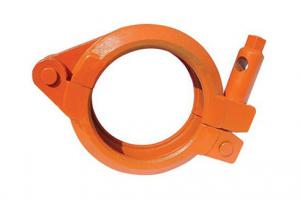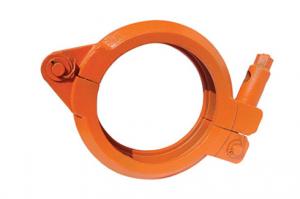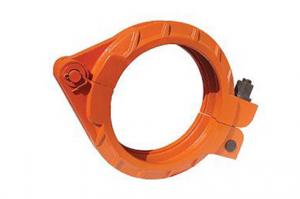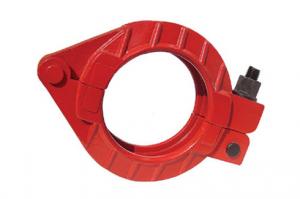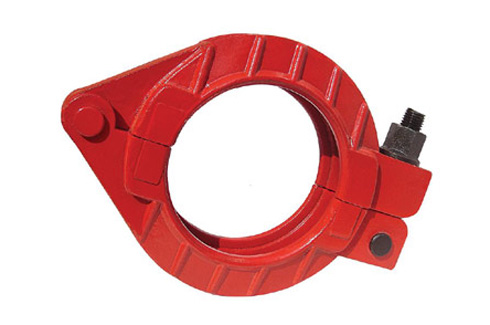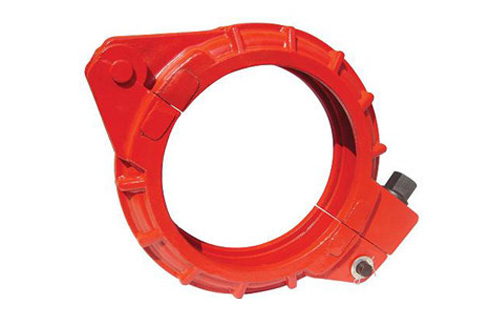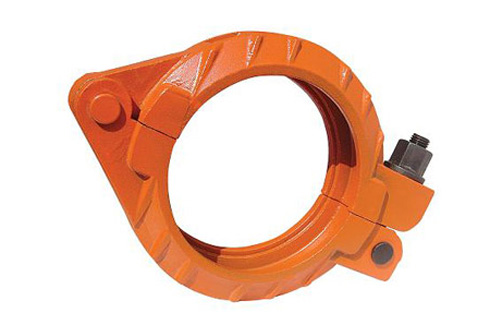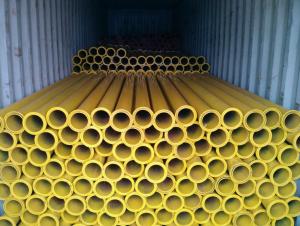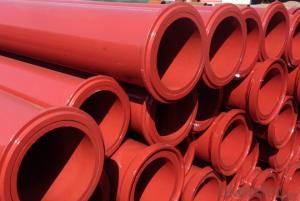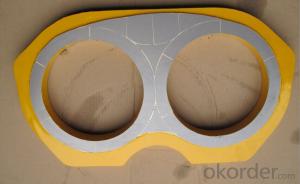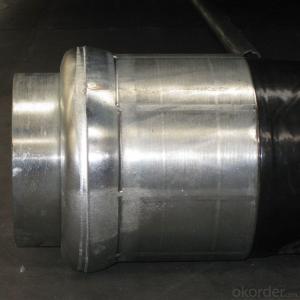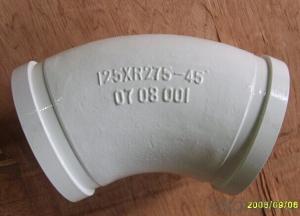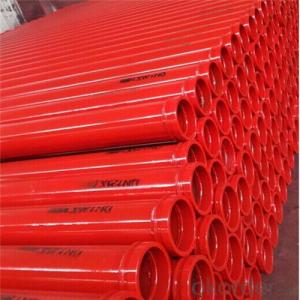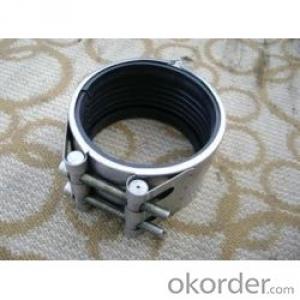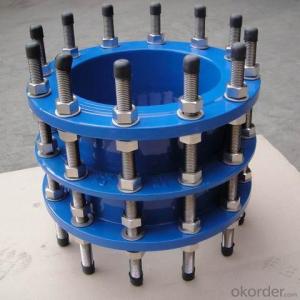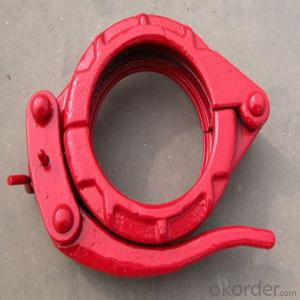Clamp Coupling DN50-DN200
- Loading Port:
- China Main Port
- Payment Terms:
- TT OR LC
- Min Order Qty:
- -
- Supply Capability:
- -
OKorder Service Pledge
Quality Product, Order Online Tracking, Timely Delivery
OKorder Financial Service
Credit Rating, Credit Services, Credit Purchasing
You Might Also Like
Size: 2"-8" (DN50-DN200)
Brand: Putzmeister, Schwing, Sany
Series: Screw Coupling, Bolt Coupling, SnapCoupling
Other products:
1) Putzmeister/ Schwing/ Zoomlion/ SermacRam Pistons
2) Putzmeister/ IHI/ Kyokuto/ Zoomlion/ SanySeperated Piston
3) Wear-resisting board and Cuts ink
4) Rubber hose
5) ST52 steel pipe, elbow, reducer
6) Cleaning seriesand others
- Q: How do I determine the correct temperature ratings for concrete pump spare parts?
- To determine the correct temperature ratings for concrete pump spare parts, you should refer to the manufacturer's guidelines or specifications. These documents usually provide information on the recommended temperature range within which the parts can function effectively and safely. It is essential to follow these guidelines to ensure the longevity and performance of the spare parts in your concrete pump system.
- Q: Can I get spare parts for concrete pump hydraulic cylinders and valves?
- Yes, spare parts for concrete pump hydraulic cylinders and valves are generally available. It is recommended to contact the manufacturer or a reputable supplier to inquire about the specific parts you need for your concrete pump.
- Q: How does a hopper vibrator prevent concrete blockages?
- A hopper vibrator is a mechanical device designed to prevent concrete blockages in construction equipment, such as concrete pumps and mixers. It works by applying vibrations to the hopper, which is the large container where the concrete is stored before it is poured or transferred. The main reason concrete blockages occur is due to the tendency of the material to settle and become compacted, especially when it is stored for a long time or during transportation. This can lead to clogging and obstruction of the flow of concrete, slowing down the construction process and potentially causing damage to the equipment. By using a hopper vibrator, the vibrations are transmitted to the concrete within the hopper, effectively preventing it from settling and compacting. The vibrations create a loosening effect on the concrete particles, ensuring that they remain in a more fluid state. This allows for a continuous and smooth flow of concrete, preventing any blockages or obstructions from occurring. Additionally, the vibrations from the hopper vibrator also help to dislodge any potential blockages that may have already formed. The shaking motion can break up clumps of concrete or other debris that might be blocking the flow, allowing for uninterrupted movement of the material. Overall, a hopper vibrator is an essential tool in construction equipment as it helps to maintain a consistent flow of concrete, preventing blockages and ensuring the smooth and efficient operation of the construction process.
- Q: How often should concrete pump remote control antennas be inspected and replaced?
- Concrete pump remote control antennas should be inspected regularly to ensure they are in good working condition. The frequency of inspections will depend on the usage and working conditions of the concrete pump. In general, it is recommended to inspect the antennas at least once a year or after every 500 hours of usage, whichever comes first. However, if the pump is used in harsh environments or experiences frequent wear and tear, more frequent inspections may be necessary. It is important to check for any signs of damage, such as cracks, corrosion, or loose connections. If any damage is detected, the antenna should be replaced immediately to prevent any disruptions in the remote control signal. Regular inspections and timely replacement of antennas will help ensure the smooth and efficient operation of the concrete pump.
- Q: Is the main pump of the concrete pump electric control or hydraulic control?
- Closed main oil pump behind the charge pump to provide a constant pressure to the displacement of the electromagnet by the current control output pressure to achieve the main pump pressure and pumping the commutation.
- Q: How can one determine the correct voltage and current rating for electrical components in concrete pump spare parts?
- Several factors must be considered when determining the appropriate voltage and current rating for electrical components in concrete pump spare parts. The first step is to consult the manufacturer's specifications and documentation for both the concrete pump and its spare parts. These documents typically provide detailed information on the voltage and current requirements for each electrical component. It is important to closely follow these guidelines to ensure that the components are operated within their intended parameters. Next, it is crucial to have a thorough understanding of the electrical system and its requirements. This involves analyzing the power supply available at the site where the concrete pump will be used. Factors such as the voltage level (e.g., 110V, 220V, 440V) and frequency (e.g., 50Hz, 60Hz) of the electrical supply must be taken into account. Additionally, the maximum current capacity of the electrical system should be considered to avoid overloading. Furthermore, it is advisable to assess the specific application and operating conditions of the concrete pump. Different components may have varying voltage and current requirements depending on their function and the environment in which they are used. For example, components installed outdoors may require higher voltage ratings to withstand harsh weather conditions. Lastly, seeking assistance from qualified electricians or engineers is highly recommended. They have the expertise and knowledge to accurately determine the voltage and current ratings for electrical components in concrete pump spare parts. Their experience allows them to consider various factors, including safety regulations, compatibility with the existing electrical system, and any specific requirements from the concrete pump manufacturer. By considering the manufacturer's specifications, understanding the electrical system, evaluating the application and operating conditions, and seeking professional advice, one can effectively determine the appropriate voltage and current rating for electrical components in concrete pump spare parts.
- Q: How much do concrete pump spare parts typically cost?
- The cost of concrete pump spare parts can vary depending on several factors such as the brand, type of part, and the supplier. On average, concrete pump spare parts can range from a few hundred dollars to several thousand dollars. Common spare parts such as pistons, seals, and wear plates tend to have lower price points, while more complex components like hydraulic cylinders or control boards can be more expensive. Additionally, the quality and durability of the spare part can also affect the price. It is advisable to compare prices from different suppliers and consider factors like warranty and customer reviews before making a purchase.
- Q: How can the concrete pump pipe be cleaned?
- Take some concrete out of the first straight pipe and connect with the air wash joint. The joint shall be filled with sponge balls soaked in water. The inlet, the exhaust valve and the compressed air hose shall be installed on the joint.
- Q: What is the purpose of a concrete pump cleaning ball?
- To effectively cleanse and eliminate any lingering concrete or debris inside a concrete pump system, a concrete pump cleaning ball serves its purpose. These cleaning balls are specifically designed for insertion into the pumping system and subsequent propulsion through the pipes using water pressure or compressed air. As they progress through the system, the cleaning balls effectively scrape away any solidified concrete or accumulation, guaranteeing unobstructed flow and optimal performance of the pump and pipes. This routine cleaning process not only prevents blockages and upholds pump efficiency but also prolongs the equipment's lifespan. Furthermore, the utilization of cleaning balls ensures that the subsequent batch of pumped concrete remains uncontaminated by any residual debris, resulting in a superior final product.
- Q: What is the purpose of a concrete pump hydraulic oil cooler?
- The purpose of a concrete pump hydraulic oil cooler is to maintain the optimal temperature of the hydraulic oil in the system. Hydraulic oil is used to power the pump's hydraulic system, which is responsible for operating various components such as the pistons, cylinders, and valves. During the pumping process, the hydraulic oil can become heated due to the constant movement and pressure exerted on the system. If the oil temperature rises too high, it can lead to a decrease in viscosity, which affects the overall performance and efficiency of the pump. Additionally, excessive heat can cause the hydraulic oil to break down and degrade, resulting in increased wear and tear on the pump's components. To prevent these issues, a concrete pump hydraulic oil cooler is used. It is typically a heat exchanger that transfers heat from the hydraulic oil to a cooling medium, such as air or water. This helps to regulate the temperature of the hydraulic oil and keep it within a safe operating range. By maintaining the optimal temperature, the hydraulic oil cooler ensures that the hydraulic system operates efficiently and effectively. It helps to prolong the lifespan of the pump by reducing the risk of overheating and excessive wear on the components. Additionally, it helps to maintain the quality of the hydraulic oil, allowing it to retain its lubricating properties and prevent any potential damage to the system. In summary, the purpose of a concrete pump hydraulic oil cooler is to regulate the temperature of the hydraulic oil in order to optimize the performance, efficiency, and longevity of the pump's hydraulic system.
Send your message to us
Clamp Coupling DN50-DN200
- Loading Port:
- China Main Port
- Payment Terms:
- TT OR LC
- Min Order Qty:
- -
- Supply Capability:
- -
OKorder Service Pledge
Quality Product, Order Online Tracking, Timely Delivery
OKorder Financial Service
Credit Rating, Credit Services, Credit Purchasing
Similar products
Hot products
Hot Searches
Related keywords
